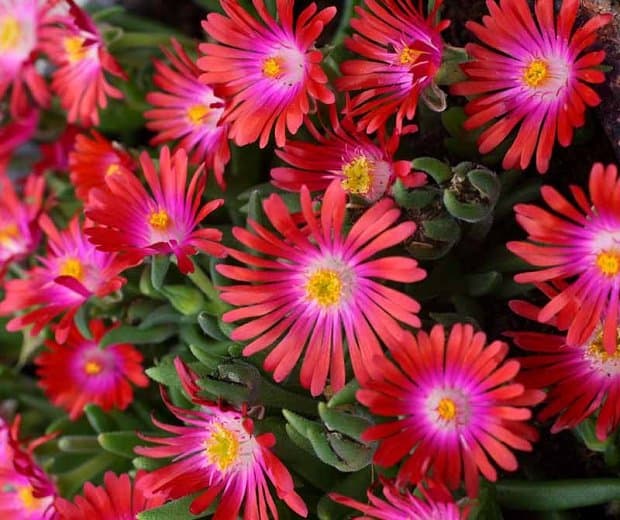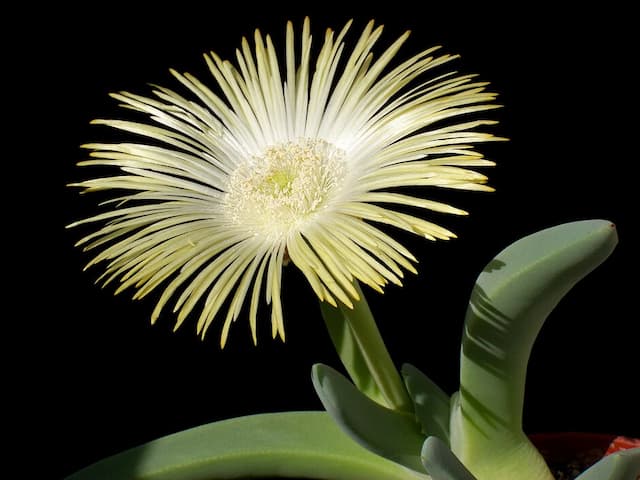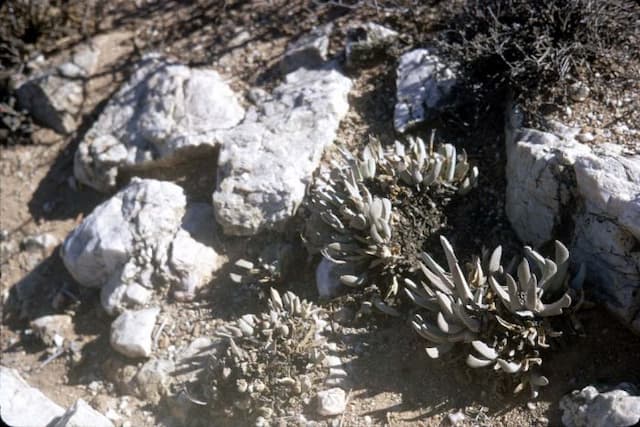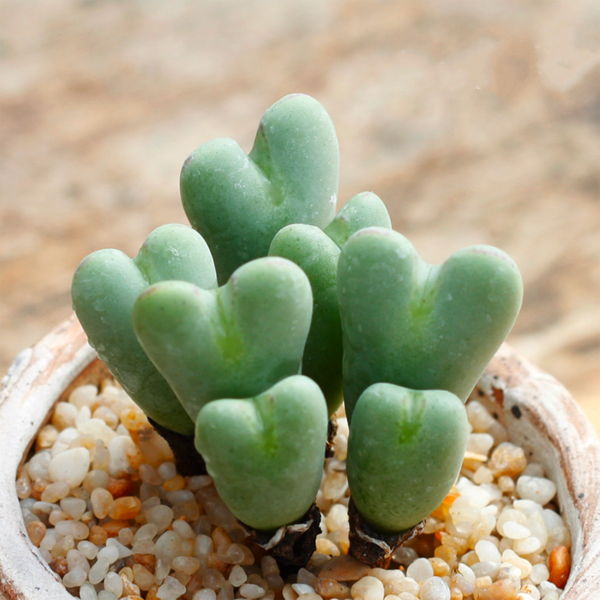Ice Plant Delosperma cooperi

ABOUT
The commonly known as ice plant, is a succulent groundcover known for its fleshy leaves and daisy-like flowers. The leaves are typically bright green, cylindrical in shape, and often have a glistening appearance that resembles tiny ice crystals, hence the common name. This succulent characteristic allows it to conserve water in its arid native habitat. The flowers of the ice plant are its most striking feature, usually vibrant magenta or purple in color with a multitude of narrow petals radiating from the center of each blossom. These attractive flowers are known to bloom profusely and can cover the plant in a stunning display of color, often from late spring to early fall, depending on the climate. The ice plant's growth habit spreads outwards, forming a dense mat of foliage that hugs the ground. This matting nature makes it a popular choice for ground cover in garden settings where it can provide a continuous carpet of color and texture. The combination of its water-retaining leaves, brightly colored flowers, and low-growing form gives the ice plant a distinctive appearance that is both practical for xeriscaping and appealing to gardeners seeking a robust, drought-tolerant option for their landscapes.
About this plant
 Names
NamesFamily
Aizoaceae.
Synonyms
Ice Plant, Hardy Ice Plant, Pink Carpet, Cooper's Ice Plant, Trailing Ice Plant.
Common names
Mesembryanthemum cooperi, Delosperma cooperi var. alba, Delosperma cooperi var. griseum, Delosperma alba, Delosperma gilbertii, Delosperma nubigenum
 Toxicity
ToxicityTo humans
Ice plant (Delosperma cooperi) is generally considered non-toxic to humans. There are no widely recognized symptoms of poisoning because it is not known to be poisonous. Ingesting parts of the plant should not cause harm, but as with any non-food plants, consuming large quantities may cause digestive discomfort due to the fiber content or individual sensitivities.
To pets
Ice plant is also typically non-toxic to pets. It is not known to cause severe symptoms of poisoning in animals such as cats and dogs. While the ingestion of non-food plants can sometimes lead to mild gastrointestinal upset in some pets, the ice plant doesn't contain known toxic compounds that would lead to significant health issues.
 Characteristics
CharacteristicsLife cycle
Perennials
Foliage type
Evergreen
Color of leaves
Green
Flower color
Magenta
Height
3-6 inches (7.62-15.24 cm)
Spread
2 feet (60.96 cm)
Plant type
Succulent
Hardiness zones
6
Native area
South Africa
Benefits
 General Benefits
General Benefits- Drought Tolerance: Once established, it can survive with very little water, making it an excellent choice for xeriscaping and arid environments.
- Ground Cover: It grows densely and can cover large areas, helping to stabilize the soil and reduce erosion.
- Easy Care: Requires minimal maintenance, doesn't need regular fertilization, and is relatively pest and disease free.
- Long Blooming: Produces vibrant pink-purple flowers that bloom from spring until the first frost, providing long-lasting color in the garden.
- Heat Resistance: Thrives in hot conditions, making it ideal for sunny, warm climates and rock gardens.
- Winter Interest: Some varieties have evergreen leaves that provide visual interest in the garden even in the winter.
- Attract Pollinators: The blossoms attract butterflies and bees, supporting local ecosystems.
 Medical Properties
Medical Properties- Traditionally used for its antimicrobial properties: Delosperma cooperi, commonly known as ice plant, may have been used in traditional medicine for its potential to inhibit the growth of certain bacteria and fungi.
- Applied to treat minor wounds and burns: The juice or extracts from the ice plant have been employed traditionally to aid in the healing of small cuts, abrasions, and thermal burns.
- Potential anti-inflammatory effects: Some sources suggest that Delosperma cooperi may possess constituents that help reduce inflammation and could have been used to soothe inflamed skin conditions.
 Air-purifying Qualities
Air-purifying QualitiesThis plant is not specifically known for air purifying qualities.
 Other Uses
Other Uses- Ground Cover: Delosperma cooperi, commonly known as Ice Plant, is widely used as a drought-resistant ground cover in rock gardens, borders, and on slopes for erosion control due to its succulent leaves and extensive rooting system.
- Decorative Displays: The vivid daisy-like flowers and succulent foliage are used in ornamental plantings to provide a burst of color in xeriscaped gardens.
- Living Roof Planting: Because of its low water needs and ability to tolerate full sun, Ice Plant is an excellent choice for green roofing projects where it can provide insulation and reduce runoff.
- Nectar Source for Pollinators: The flowers attract bees, butterflies, and other pollinators, enhancing the biodiversity of the garden ecosystem.
- Culinary Interest: Although not a common practice, the plant’s leaves can be used in small quantities to add a sour taste to salads or as a cooked green.
- Firebreak Planting: In areas prone to wildfires, Ice Plant can serve as a fire retardant ground cover due to its high moisture content.
- Crevice Filler: The plant's spreading habit and tolerance for poor soil make it suitable for planting in between pavers or rock walls, filling gaps and creating a cohesive landscape design.
- Educational Use: Ice Plant can be studied in schools or botanical gardens to educate about succulent plants and their adaptations to arid environments.
- Photography Backdrops: The striking appearance of the Ice Plant, with its bright flowers against fleshy green leaves, can provide a vibrant backdrop for garden photography.
- Companion Planting: The Ice Plant can be used in combination with other drought-tolerant species to create diverse, water-wise garden beds that require minimal maintenance.
Interesting Facts
 Feng Shui
Feng ShuiThe Ice Plant is not used in Feng Shui practice.
 Zodiac Sign Compitability
Zodiac Sign CompitabilityThe Ice Plant is not used in astrology practice.
 Plant Symbolism
Plant Symbolism- Survival and Resilience: Delosperma cooperi, commonly known as Ice Plant, often symbolizes survival and resilience because it can thrive in harsh, dry environments and quickly recover from adverse conditions.
- Drought Resistance: Reflecting its ability to withstand periods of drought, the Ice Plant symbolizes endurance and the capacity to adapt to challenging circumstances.
- Grounding: As a groundcover plant that spreads across the soil, Ice Plant can represent grounding, stability, and the importance of laying a strong foundation.
- Luminosity and Clarity: The bright, glistening appearance of the Ice Plant's foliage, especially after rain, symbolizes luminosity, clarity, and the beauty of light reflecting off a solid surface.
- Vibrant Life: The vivid flowers of Ice Plant are often associated with vibrancy, joy, and a celebration of life's colorful moments.
- Resourcefulness: With its succulent leaves that help store water, the Ice Plant can symbolize resourcefulness and the smart use of available resources.
 Water
WaterThe Ice Plant, also known as Delosperma cooperi, should be watered thoroughly but infrequently. This succulent thrives best with a soak-and-dry method, meaning you should let the soil dry out completely before rewatering. Typically, watering once every two weeks is sufficient, but this may increase to once a week during hot, dry periods. When you water, apply approximately one gallon directly to the base of the plant, ensuring you avoid getting water on the foliage or flowers to prevent any rot.
 Light
LightIce Plant prefers full sun exposure, thriving in bright and direct lighting conditions. Situate your Delosperma cooperi in a spot where it can receive at least six hours of direct sunlight daily. In regions with particularly intense sun, it may benefit from light shade during the hottest part of the day to prevent leaf scorch.
 Temperature
TemperatureThe Ice Plant can withstand a range of temperatures, with ideal conditions being between 40°F and 90°F. It is hardy and can generally survive minimum temperatures down to around 20°F, but prolonged exposure to cold below this can be detrimental. In contrast, it can handle high temperatures but should be protected from extreme heat beyond 90°F to avoid stress.
 Pruning
PruningPruning Ice Plant is essential for maintaining a compact form and encouraging dense, vigorous growth. Remove spent flowers and trim back overgrown stems in early spring before new growth starts. Pruning once a year is usually sufficient to keep your Delosperma cooperi looking its best. Cut away any damaged or dead tissue at this time to promote new, healthy growth.
 Cleaning
CleaningNot needed
 Soil
SoilIce Plant (Delosperma cooperi) thrives in well-draining soil with a sandy or gravelly mixture to mimic its natural habitat. The best soil mix consists of two parts potting soil, one part sand, and one part fine gravel or perlite to ensure proper drainage. Maintain a slightly acidic to neutral pH of 6.0-7.5 for optimal growth.
 Repotting
RepottingIce Plant (Delosperma cooperi) has a shallow root system and generally doesn't require frequent repotting. It is best to repot every 2 to 3 years or when it outgrows its current container to refresh the soil and provide room for growth.
 Humidity & Misting
Humidity & MistingIce Plant (Delosperma cooperi) is tolerant of dry air and prefers low humidity conditions typical of arid environments, making it well-suited for typical indoor humidity levels.
 Suitable locations
Suitable locationsIndoor
Place Ice Plant near a sunny window and in well-draining soil.
Outdoor
Plant Ice Plant in full sun with well-draining soil; protect from winter wet.
Hardiness zone
6-10 USDA
 Life cycle
Life cycleDelosperma cooperi, commonly known as the Ice Plant, begins its life as a seed, which upon germination in warm, well-draining soil, develops into a seedling with fleshy leaves indicative of its succulent nature. As the seedling matures, it develops a shallow but spreading root system and grows into a low, mat-forming perennial. Flower buds emerge in late spring to early summer, opening into vibrant, daisy-like purple or pink flowers that attract pollinators. After pollination, flowers develop into small capsules containing seeds. Throughout the growing season, the Ice Plant continues to spread and can form dense carpets of succulent foliage. The plant enters dormancy in winter, reducing growth and water needs, but with appropriate protection from extreme cold, it will revive with the return of warmer temperatures in spring.
 Propogation
PropogationPropogation time
Spring-Early Summer
The Ice Plant, known scientifically as Delosperma cooperi, can be propagated through stem cuttings, a method that is both popular and effective for this succulent. The best time to take stem cuttings for propagation is during the spring or early summer, when the plant is actively growing. To propagate, select a healthy and non-flowering stem and cut it with a clean, sharp pair of scissors or a knife, ensuring the cutting is about 3 to 5 inches (approximately 7.6 to 12.7 centimeters) long. Allow the cutting to callous over for a few days to prevent rotting when planted. Once the end of the cutting has dried and formed a callous, place it in a well-draining soil mix, barely covering the base with soil. Water sparingly, just enough to keep the soil slightly moist, and place the cutting in bright, indirect light. Roots typically develop within a few weeks, and new growth will indicate a successful propagation.



![Ice plant [Fire Spinner]](/_next/image?url=https%3A%2F%2Fplants-admin.emdemapps.com%2Fimages%2Fplants%2F%2Fimages%2F604b54d98722a.png&w=640&q=75)





